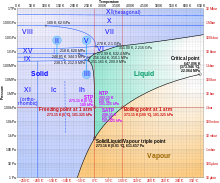氷Ic相
表示
氷Ic相(こおりいちシーそう、Ice Ic)は、氷の準安定状態の立方晶系結晶である。ハンス・ケーニヒがその構造を初めて確認し、記述した[1]。氷Ic相の酸素原子は、ダイヤモンド状に配列するが、氷Ih相とほぼ同じ密度と充填方向の同じ格子定数を持ち、非常によく似ている[2]。冷却すると-143℃から-53℃の間で形成され、その後加熱すると-33℃まで存在し[3][4]、氷Ih相に転移する。

過冷却の水から形成される他[5]、アモルファスや高圧の氷II、氷III、氷Vからも形成されることが報告されている[6]。上層大気中にも存在することがあり[7]、これは、太陽または月からの視野角28度近くで発生する珍しいリングである「28度ハロ」(Scheinerのハロ)の観測に関与していると考えられている[8]。
通常の氷は、ブリッジマン命名法によると、氷Ih相として知られる。実験室においては、異なる温度と圧力の下、氷IIから氷XIXまでの異なる種類の氷が作られている[9]。
完全な立方晶の氷Ic相の合成が難しかったことから、氷Ic相という氷多形は存在せず、既存の方法で作られる「氷Ic相」は積層不整のある氷I相("氷Isd相")と呼ぶべきであるという主張もあった[10][11][12]が、2020年にKomatsuら[13]は、C2水素ハイドレートから水素分子を抜き取ることによって積層不整のない氷Ic相を作ることに成功した。また、del Rossoらも同時期に、氷XVII相を常圧で加熱することにより積層不整のない氷Ic相の作成に成功している[14]。
脚注
[編集]- ^ Konig, H. (1943). “Eine kubische Eismodifikation”. Z. Kristallogr. 105 (1): 279-286. doi:10.1524/zkri.1943.105.1.279.
- ^ Dowell, L. G.; Rinfre, A. P. (1960). “Low-temperature forms of ice as studied by x-ray diffraction”. Nature 189 (4757): 1144-1148. Bibcode: 1960Natur.188.1144D. doi:10.1038/1881144a0.
- ^ Murray, B.J.; Bertram, A. K. (2006). “Formation and stability of cubic ice in water droplets”. Phys. Chem. Chem. Phys. 8 (1): 186-192. Bibcode: 2006PCCP....8..186M. doi:10.1039/b513480c. hdl:2429/33770. PMID 16482260.
- ^ Murray, B.J. (2008). “The Enhanced formation of cubic ice in aqueous organic acid droplets”. Env. Res. Lett. 3 (2): 025008. Bibcode: 2008ERL.....3b5008M. doi:10.1088/1748-9326/3/2/025008.
- ^ Mayer, E.; Hallbrucker, A. (1987). “Cubic ice from liquid water”. Nature 325 (12): 601-602. Bibcode: 1987Natur.325..601M. doi:10.1038/325601a0.
- ^ Bertie, J. E.; Calvert, L. D., Whalley, E. (1963). “Transformations of Ice II, Ice III, and Ice V at Atmospheric Pressure”. J. Chem. Phys. 38 (4): 840-846. Bibcode: 1963JChPh..38..840B. doi:10.1063/1.1733772.
- ^ Murray, B.J. (2005). “The formation of cubic ice under conditions relevant to Earth's atmosphere”. Nature 434 (7030): 202-205. Bibcode: 2005Natur.434..202M. doi:10.1038/nature03403. PMID 15758996.
- ^ Whalley, E. (1981). “Scheiner's Halo: Evidence for Ice Ic in the Atmosphere”. Science 211 (4480): 389-390. Bibcode: 1981Sci...211..389W. doi:10.1126/science.211.4480.389. PMID 17748273.
- ^ “Neue kristalline Eisform aus Innsbruck” (ドイツ語). Universitat Innsbruck. 2021年2月18日閲覧。
- ^ Murray, Benjamin J.; Salzmann, Christoph G.; Heymsfield, Andrew J.; Dobbie, Steven; Neely, Ryan R.; Cox, Christopher J. (2015). “Trigonal Ice Crystals in Earth's Atmosphere”. Bulletin of the American Meteorological Society 96 (9): 1519-1531. Bibcode: 2015BAMS...96.1519M. doi:10.1175/BAMS-D-13-00128.1.
- ^ “Stacking disordered ice; Ice Isd”. lsbu.ac.uk. 3 December 2019閲覧。
- ^ Malkin, Tamsin L.; Murray, Benjamin J.; Salzmann, Christoph G.; Molinero, Valeria; Pickering, Steven J.; Whale, Thomas F. (2015). “Stacking disorder in ice I”. Physical Chemistry Chemical Physics 17 (1): 60-76. doi:10.1039/C4CP02893G. PMID 25380218.
- ^ Komatsu et al. (2020). “Ice Ic without stacking disorder by evacuating hydrogen from hydrogen hydrate”. Nature Communications 11 (1): 2-4.
- ^ del Rosso et al. (2020). “Cubic ice Ic without stacking defects obtained from ice XVII”. Nature Materials 19 (6): 663-668.
参考文献
[編集]- Chaplin, Martin (16 July 2007). “Cubic ice”. Water Structure and Science. 2 January 2008閲覧。
